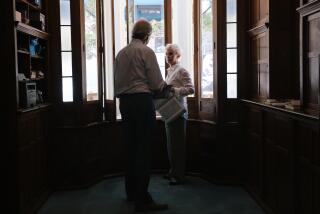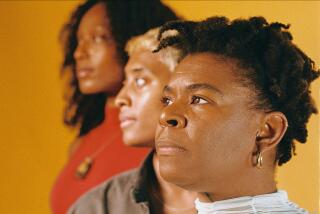Sex, Seriously
- Share via
It may have been a first: a bachelor party that doubled as a safe-sex workshop.
But it didn’t seem altogether unusual to the groom, Harley “R.J.” Curtis III of Orange. He had agreed to allow AIDS counselor Kela Taylor to come and lecture him and his 40 or so buddies on HIV and AIDS before the serious partying began.
Not unusual, that is, until the party’s dozen strippers, who were supposed to wait in another room, decided to sit in on the workshop too.
After self-conscious joking ran its course, Curtis said, some real education began for both the men and women. When one 23-year-old guest wanted more information about condoms, Taylor produced a model of a penis and demonstrated techniques for putting on the latex sheaths. Curtis, a 29-year-old barber, said the presentation was well received.
“The guys were all interested and had a lot of questions,” Curtis said. “Some things, as far as transmitting diseases, I’d never heard of.”
Taylor, 27, of Fullerton gave a similar presentation at a party for Curtis’ bride.
Taylor enlivens her presentations by emphasizing that using condoms can be part of the playfulness of sex rather than an unwelcome intrusion.
“Reaching into a bedside drawer for a condom can really interrupt things,” she said. “We need to find ways to incorporate [protection] more easily into sex.”
As young African Americans, Curtis and his friends are prime targets of the AIDS education program of Hannah’s Childrens Homes, a private, nonprofit social services agency based in Orange.
The 2-year-old project, called Unamju, is low-budget--just $50,000 a year--and provides employment referrals and other support for HIV-positive clients. Unamju, which means “Do you know?” in Swahili, uses federal funds administered by Orange County and complements a similar program for Latinos run by another group. Both share the goal of reaching minority groups whose HIV infection rate is higher than that of whites.
From 1990 to 1994, the annual AIDS incidence rate grew 68% among blacks nationwide, compared with 14% among whites, the Centers for Disease Control reports. Of all ethnic groups, the rate of reported AIDS cases in 1995 was highest among African Americans.
In Orange County, although blacks make up just 2% of the population, their percentage of diagnosed AIDS cases in 1995 was 5%, said Robert F. Gentry, chair of the Orange County HIV Planning Advisory Council.
At the same time that infection rates are rising, minority groups are likely to miss centralized education efforts, he said.
“When dealing with communities that have a low portion of the population within the county, they often don’t have access to mainstream information, publications and health data,” Gentry said. “So it’s important to have specific programs for those populations.”
The need for education among blacks is reflected in the program’s name, said Elizabeth Pringle-Hornsby, director of social services at Hannah’s.
Vera Ray, coordinator of the education project, said many of the heterosexuals she speaks with in fact know little about HIV transmission and risk factors.
“People are still having unprotected sex--men and women,” she said. “They’re lacking knowledge of transmission and don’t know what an [HIV] test means.
“It’s amazing, the stories we hear. People will get tested negative [for HIV] and then go out and [have unprotected sex]. And they say [in defense], ‘Well, I got tested.’ ”
Ray said one communication challenge is that, except for small pockets in Buena Park and Santa Ana, the African American population in Orange County is scattered.
She has tried to remedy that by targeting black-owned businesses, and none, she said, are more a beehive of communication than beauty salons. As Ray said: “You tell a beautician your business.”
“I have some good talks with the beauticians and their clientele,” said Ray, who tries to make two or three return visits each month to the 15 salons she has contacted. “But it takes a couple trips before someone will ask, ‘So where can I get tested?’ It takes that long.”
On a recent afternoon, Ray was at Marilyn’s Hair Design in Orange’s Old Towne, passing out literature to beauticians and showing a 10-minute video from the California AIDS Prevention Campaign, “Protecting Your Customers, Protecting Your Friends.”
“As much as everyone talks in these places, I guess it’s a good place for this program,” said DeVonda Nelson of Orange, who was getting a trim while she watched the video.
Salon owner Marilyn Epps-Taylor said the AIDS literature, especially the scratch-off cards that contain quizzes about HIV and AIDS, has accomplished its purpose at her salon. “It’s all very informative. We laugh, and we talk, and we become serious about it.”
Ray has also presented her workshops at black student union meetings at local community colleges. But she’s been frustrated by some churches’ lack of interest.
“Historically, when black people have needed to organize or get the word out, they’ve used the churches,” Ray said. “But some churches don’t want to hear our message; they think we’re promoting sex.”
One of the exceptions is Johnson Chapel, an African Methodist Episcopal church in Santa Ana, which recently collaborated with Hannah’s on a seven-Sunday series on HIV education.
“In the black community, many live with AIDS, but a lot of churches tend to ignore it or not mention the ‘A’ word,” said the Rev. Timothy Tyler, pastor of the 450-member church.
“Churches are still afraid of it. People associate it with homosexuality, and there’s a lot of homophobia in the church. A lot. Way back when, cancer was a touchy issue, and even some older people today don’t say the ‘C’ word much. Now it’s AIDS.”
Johnson Chapel is assembling a working group at the church to explore ways of ministering to people with AIDS. For Ray, it is one important step in a long road the black community must walk.
“People are starting to network more, get more comfortable with it,” she said. “It’s all about protecting each other.”
* For additional information on Unamju, contact Hannah’s Childrens Homes in Orange, (714) 516-1077. For information on a similar program directed toward the Latino community, call Delhi Community Center, (714) 549-1317.






